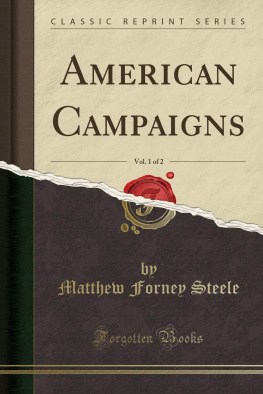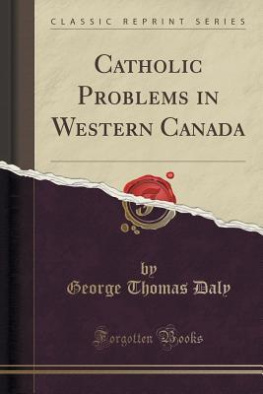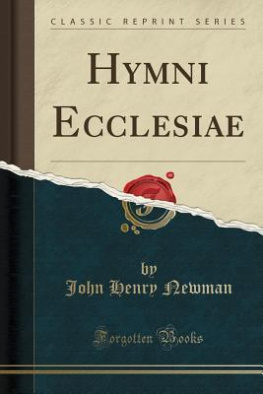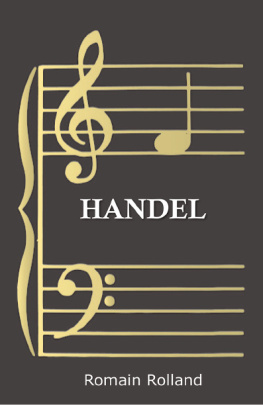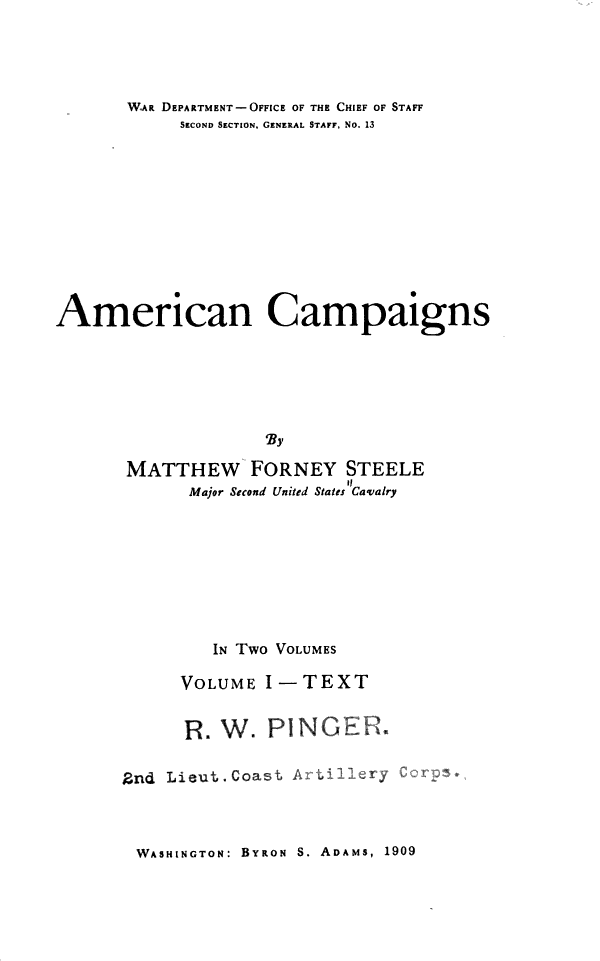

PREFACE.
These volumes represent a part of my three years' work as lecturer in military history at the Army Service Schools at Fort Leavenworth. It is with a great deal of reluctance that I have consented to let the lectures be printed in their present form, for no one can know better than I how far they fall short of being a finished work. No doubt, however, I should not feel entirely satisfied with them if I had spent twenty years, instead of only a part of three, upon them.
No man can feel that he has thoroughly mastered any campaign or battle, or is fully equipped to lecture upon it, until he has studied everything that has been written upon it. Hence I do not feel that I have mastered a single campaign or battle discussed in this series, because I have not had time to study the tenth of what has been written upon any one of them. The Rebellion Records have virtually been a closed book for me; I have hardly dared to open them, Test I might yield to the temptation to read on, from one report to another, far beyond the time I have had to spare. Fortunately, however, this great mine of fact and fiction has been industriously worked, and its contents have been carefully sifted and reduced, by such skilful craftsmen as Mr. John Codman Ropes, General E. P. Alexander, and dozens of others, who have given many years of their lives to the task; and the" product of their expert labor has been placed at the disposal of students having less time to spare, like myself.
There is so much, however, I could do to improve the lectures and make them more valuable and acceptable, that I regret I cannot put one more year's work upon them before sending them forth; but they cannot wait longer, for some work of this kind is sadly needed by the students at the Service Schools in connection with their course in military history. These volumes are intended to occupy a space not filled by any other single work, and, until something better shall be provided, they must answer the purpose.
In preparing the lectures for publication I have been assisted directly or indirectly by many persons without whose aid I should never have succeeded at all. It would be impossible even to name them all. To no one else do I feel so much indebted as to Captain Edwin T. Cole, 6th Infantry, Senior
Instructor, Department of Engineering, at the Service Schools, under whose direction and supervision the maps were made. Indeed I believe I may say that Captain Cole was the initiator of the whole project. The volumes are the outcome of my course of lectures, which were illustrated by means of the stereopticon* . For this series of lectures Captain Cole with his own hand made more than six hundred lantern-slides, nearly all of which had troops represented upon them in colors laid on by hand under the magnifying-glass. In the preparation of the maps, Captain Cole was assisted by Sergeant John Howry, Co. D, 1st Battalion of Engineers, a skilful draftsman, and Sergeant Frank Arganbright, Co. A, Signal Corps, an expert photographer. The final tracings of all the maps were done by Mr. W. J. Jacobi and Mr. A. B. Williams, expert draftsmen in the Military Information Committee, Second Section, General Staff, U. S. Army. For the excellence of the plates I am indebted to the personal care of Mr. W. Palmer Hall, of The Maurice Joyce Engraving Co., and for the accurate "registering" of the color-plates to the painstaking of Mr. D. S. White and Mr. William E. Browne, of the house of Byron S. Adams. To Mr. S. C. Williams, clerk in the office of the Secretary of the Service Schools, I am particularly obliged for the speed and accuracy with which he made the fair copy of my manuscript for the printer.
None of the maps were drawn originally for these lectures; all are photographic reproductions of either official maps or maps accompanying works that have been consulted in the preparation of the lectures. For the privilege of reproducing the maps of other works I have had to ask several authors and almost every leading publisher in the country, all of whom, both authors and publishers, have been kind enough to give their consent. Since, however, the maps have been taken from many different sources, they will be found to possess no sort of uniformity in method or in quality. Better maps, no doubt, are in existence than many of those reproduced, but the best one available has been taken in every case. In most cases the colored blocks and lines representing troops and routes of march have been added specially for the lectures. It has seldom been possible to represent the troops to a scale, the main purpose having been merely to suggest, by means of blue and red blocks, the relative positions of hostile troops on a battle-field or in a theater of operations.
*a slide projector that combines two images to create a three-dimensional effect, or makes one image dissolve into another.All things considered, it has been deemed best to present the maps in a separate volume of the same size as the volume of lectures, and to limit them to such dimensions that none of them shall require folding; but in reducing some of them to a scale small enough to meet these requirements, many of the geographic names have been made rather small to read with the naked eye; but it may be remarked, in passing, that no one can hope to keep his eyes unimpaired who undertakes the serious study of military history without the aid of a reading-glass. Many of the names and details of the originals not mentioned in the lectures have been left out of the reproductions and great pains have been taken to see that no important geographic names mentioned in the lectures should be omitted from the corresponding maps.
While reference is made in foot-notes throughout the text to works that have been quoted or taken as authority, I must here invite the attention of students of American military history to a few works that I believe will be of special interest to them:
For the study of the colonial period of our history Francis Parkman has left an immortal Work in his series of volumes.* His Montcalm and Wolfe and A Half Century of Conflict are of particular interest to the student of American military history.
Upon the Revolutionary War, The American Revolution, by John Fiske.f is too well known to require any recommendation from me. Its popularity is due largely to Mr. Fiske's charming style. Sydney George Fisher's True History of the American Revolution, and his later and more extensive work, The Struggle for American Independence,^, are invaluable to the American who wishes to get an unbiased view of our
*Published by Little, Brown and Company, Boston.
Published by Houghton Mifflin Company, Boston.
Both published by J. B. Lippincott Company, Philadelphia.
forefathers' struggle for freedom. The author breaks out of the usual rut of American historians, and gives us a view of the quarrel from the Englishman's side as well as from the American's. To the military student in search of the lessons of the Revolutionary War that relate to his own chosen profession, Battles of the American Revolution* written by General Henry B. Carrington, soldier and student of the science of war, makes a special appeal.
Excellent accounts of the War of 1812 are contained in Henry Adams's History of the United States,^ and A History of the People of the United States,

